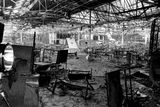‘Stardust tragedy is always in our mind’ – experts hope safety changes mean nightclub blaze cannot be repeated
Regulations have been overhauled in years since fire


There were chains on doors, carpet tiles lining the walls, steel plates welded to toilet windows, and staff at the nightclub in Artane had no training in fire drills.
The horrific Stardust tragedy more than 40 years ago was possibly the worst case of negligence and mismanagement in Ireland, according to Pat Kenny, chairman of the Irish Congress of Trade Unions’ health and safety committee.
Forty-eight young people who never came home that night were trapped in an inferno that reached 1,200C in less than two minutes.
“The Stardust tragedy is always in our mind when we think about health and safety,” Mr Kenny said.
An inquest into the disaster heard the architects who designed the nightclub had little or no knowledge of fire safety.
There was no sounding fire alarm. It only sent a signal to the management office, as Dublin Corporation had insisted this would avoid panic in the event of an emergency.
A fire swept through the venue’s polyurethane seats before filling the main dance hall with thick smoke in the early hours of Valentine’s Day 1981.
Most of those inside did not realise the situation was serious until screens went up at a partitioned off area where the fire was first seen.
It was too late for so many. The chaotic scene that firefighters came upon less than 10 minutes after an initial 999 call was described by a fire-safety expert at the inquest as something like the Grenfell Tower disaster.
Most of those who perished had probably already died.
Martin Davidson, who has 29 years’ experience as a fire engineer, told the inquest that management failed to comply with 16 by-laws out of a total of 26 they had to adhere to.
In the years that followed, there was a complete overhaul in fire-prevention measures and laws in Ireland.
In 1981, a Fire Services Act laid out effective levels of fire training, planning and prevention measures and powers available to fire services during an incident.
Building regulations have also improved. There is a duty of care on every person with control over a premises to make provision for everyone there, and provide adequate and well-maintained fire-fighting equipment in the building.
An increase in firefighters and fire stations was a direct result of the blaze, according to Dublin Fire Brigade’s chief fire officer Dennis Keeley.
Dublin Fire Brigade’s chief fire officer Dennis Keeley. Photo: Collins
He was among the new recruits in 1986. There is more training and better equipment available, he added.
However, Siptu retained firefighters who went on strike last year over terms and conditions have claimed there were serious staff shortages.
Since the tragedy, training for staff in all workplaces in evacuation procedures has become the norm.
Pádraig Ó Longaigh, senior assistant chief fire officer in Meath who inspects buildings on a regular basis, said there are some really good places and some where “you have to get the stick out”.
Overall, he says the standards are definitely higher than they would have been in the 1980s.
“All new buildings, bar family homes, require a fire cert,” he said.
“If we have to tell a premises they must improve, they won’t get their licence unless they do that work.
“There are always outliers out there who will take chances. That’s why we have to be out there in terms of enforcement.
“Fire officers are doing their best but it requires constant regulation. It’s only as good as the regulation of it.”
Mr Kenny said the there is no doubt that the Stardust tragedy would have figured in the Barrington Commission’s discussions. The commission led to the establishment of the Health and Safety Authority and the 1989 Safety Health and Welfare at Work Act.
He said the importance of managing health and safety is now obvious to everyone.
“Hopefully the changes made will ensure that a tragedy like the Stardust will never recur,” he added.
Join the Irish Independent WhatsApp channel
Stay up to date with all the latest news

















